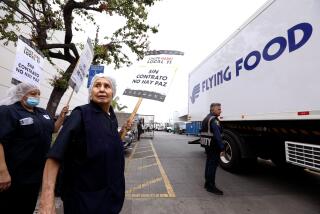Union Tries ‘Pension Power’ on B of A
The campaign recently started by a major union against Bank of America just might serve as an intriguing example of how billions of dollars in workers’ pension funds can be used as an alternative to strikes in many instances.
The United Food & Commercial Workers’ campaign is based on a federal labor law, the Taft-Hartley Act, which requires both management and union representatives to serve as joint trustees of certain multi-employer pension funds, primarily in the unionized sector of the construction industry.
That means that unions have an equal say with management in deciding where to invest the $272 billion in those so-called Taft-Hartley funds. (There is $2.7 trillion in all private pension funds, but only Taft-Hartley funds are required by law to be jointly administered. Most funds are controlled by management alone.)
The UFCW goal is to block Bank of America’s effort to invest a chunk of that sum, which, of course, it would do for a tidy fee.
Reasons? An 11-year-long labor dispute at a Bank of America subsidiary and a new organizing drive by the union among employees within Bank of America itself. UFCW President William Wynn, AFL-CIO President Lane Kirkland and other top union leaders are appealing to pension fund trustees to avoid B of A when investing fund money.
Bank Chairman A. W. Clausen will not lightly give up the company’s so-far successful effort to maintain its status as a union-free corporation. After all, it has been a tradition with the bank since it was founded as the Bank of Italy in 1904. And bank spokesman Peter Magnani says a change is most unlikely.
The bank hopes, he said, that the union-management trustees of the pension funds will invest money through Bank of America “based on the quality of our service,” and not on the bank’s dispute with the union.
But perhaps Clausen will reconsider the bank’s anti-union stance if the union campaign works and Bank of America is denied a few billion dollars of pension fund investment money.
Few banks around the country have had “union trouble” over the years even though the wages of bank tellers--almost all of whom are non-union--are generally much lower than wages of hundreds of thousands of unionized cashiers in supermarkets.
Bank of America was not concerned much about unions until 1982, when it acquired the Seattle First National Bank (Seafirst), one of the few banks with a union. Seafirst’s employees had been represented since 1938 by a small, independent labor association composed only of Seafirst employees.
After nearly 40 years of peaceful relations, the association got into a contract dispute with Seafirst 11 years ago. After going without a contract for three years, the small association sought help by affiliating with the 1.3 million-member United Food & Commercial Workers.
But that affiliation only intensified management’s opposition to the union and Seafirst has continued to battle the union in numerous legal proceedings.
The bank claims that a majority of its employees didn’t want to merge with the national union.
The union insists, though, that the merger was approved by a secret ballot vote of the association members and that the association, now a UFCW local, is still the legal representative of the bank’s employees.
The union has won most legal battles over the years, and it won again two weeks ago in a ruling issued by the 9th Circuit Court of Appeals.
About the time that the small Seafirst employees’ association gained strength in 1982 by joining the huge national union, Seafirst itself got some powerful help by affiliating with the gigantic Bank of America.
Bank of America officials insist that Seafirst managers are free to decide how to deal with the union issue themselves. Perhaps. But the managers can hardly ignore the 22-page guide that the parent bank distributes to all of its supervisors: “Preserving Your Right to Manage Union-Free.”
The guide gives supervisors such instructions as how to spot the first telltale signs of union organizing: Keep on the lookout for small groups of employees who are chatting together in “out-of-the-way places” but scatter when a supervisor appears.
And supervisors are told that higher bank authorities are available 24 hours a day through emergency phone numbers in San Francisco and Los Angeles if the local people “observe any activity which leads you to believe that a union drive is under way.”
It is hard for the union to keep the loyalty of its members at Seafirst in the face of strong management resistance that only intensified when it joined anti-union Bank of America.
But the same reason that attracted the employees to the union in the first place may explain why many of them are sticking with the union despite management’s antagonism: money.
The union keeps reminding Seafirst tellers that they earn an average of about $7 an hour while cashiers in nearby unionized supermarkets earn $11.45. The bank did not challenge the union estimate.
If the union’s pension fund tactic against Bank of America succeeds at Seafirst and then at other Bank of America offices that are now union organizing targets, it could spur similar campaigns as an alternative to strikes in labor disputes in banking and other industries.
More to Read
Inside the business of entertainment
The Wide Shot brings you news, analysis and insights on everything from streaming wars to production — and what it all means for the future.
You may occasionally receive promotional content from the Los Angeles Times.










